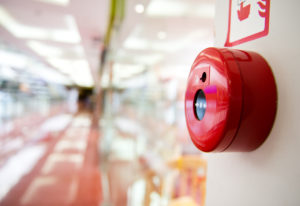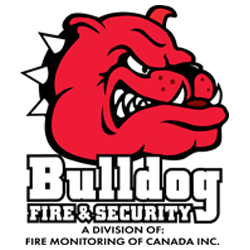Fires cause hundreds of millions of dollars in damage every year, making them top of mind for building owners and facility managers. When considering a fire alarm system for your building, it’s important to understand how the systems work, and be knowledgeable of the applicable regulations.
This Guide to Fire Alarm Systems reviews the components of a fire alarm system, the different types of systems, and speaks to the benefits of installing a fire alarm system in your building.
What is a Fire Alarm System?
A fire alarm system is made up devices such as heat and/or smoke detectors and pull stations, which indicate to a control panel that a fire has been detected and then alert building occupants to evacuate via audible and/or visual signalling devices.

Components of a Fire Alarm Systems
A fire alarm system is made up of several different input and output components, including:

- Control Panel – this is the brain of the system, and is the central hub that monitors inputs. The control panel also controls output actions and sends information to notification devices.
- Power Supplies – when it comes to powering your fire alarm system, both a primary and back up power sources are required.
- Initiating Devices – these devices transmit a signal to the fire alarm control panel indicating that there is a possible fire. There are two types:
- Automatic – automatic devices are typically detectors that can measure or identify the presence of smoke, heat, CO2, and flame. Examples include smoke or carbon monoxide detectors.
- Manual – manual devices require a person to activate them. These include items such as pull stations or alarm buttons.
- Notification Appliances – notification appliances are audible and visual signalling devices that alert building occupants of a fire. Sirens, speakers, and strobes (flashing lights) are all examples of notification appliances.
- Building Safety Components – these components allow the fire alarm system to control aspects of the building environment. These typically are used to help people exit the building safely, such as exit lighting or ventilation systems.
Additionally, systems may also include sprinklers, fire doors, and elevator recall activators, among many others. They may also be integrated with your building’s security system or other smart building technologies.
Types of Fire Alarm Systems
There are two primary types of fire alarm systems, conventional and addressable. While both interact with devices and other components in a similar fashion, they differ in how they are connected.
- Conventional: A conventional fire alarm system connects the control panel with each device on a separate wire, and are typically set up on zones. This way, when a device is activated, the system can identify the zone, and help narrow down the location of a potential fire. For example, if your building has four floors and each floor is set up as a zone, the fire department can identify which floor the fire is located on based on the zone that is activated.
- Addressable: An addressable fire alarm system assigns a unique address to each device on the system. This means that you can identify the exact location of an activated device and advise fire personnel. All of the devices within a building are connected on one wire that is looped to the control panel. Because of this, if one end gets damaged, the system can still send communication to the control panel through the other end of the loop. These systems are very customizable, and are generally used for large buildings or complexes.
Benefits of a Fire Alarm System
There are countless advantages to installing a fire alarm system within your building. From life safety to protection from fire damage, here are just a few of the benefits of having a fire alarm system in your facility:
- Warning – fire alarm systems can use audible alerts to give building occupants notification of an emergency, and prompt them to escape a dangerous situation.
- Fire Alarm Monitoring – together with your fire alarm system, fire monitoring connects your building with your fire alarm monitoring provider who is then the liaison with the local fire department, alerting them if there’s a fire in your building.
- Early Detection – a properly functioning fire alarm system can make it possible to detect a fire quickly. Together with a fire alarm monitoring system, it can allow fire fighters to respond quickly. This is critical in helping to avoid major damage to your building.
- Insurance Discounts – having a fire alarm system installed in your building can help you save money on your building insurance.
Learn More

For 19 years, Bulldog Fire and Security has been an expert in fire alarm system installation and service, having installed a variety of systems throughout Southwestern, Ontario.
To learn more about fire alarm systems and installation, call us at 1 866 670 1590, email info@bulldogsecurity.ca, or fill out the contact form below.

